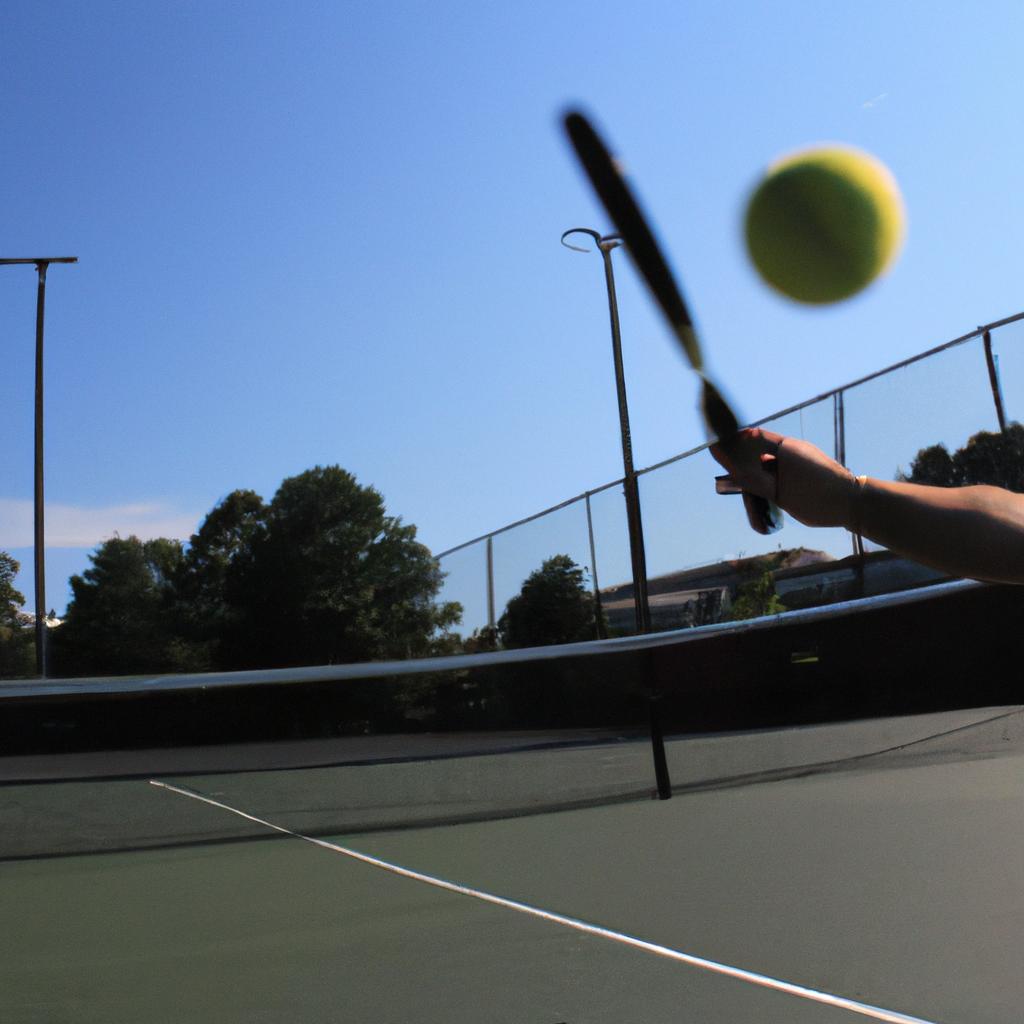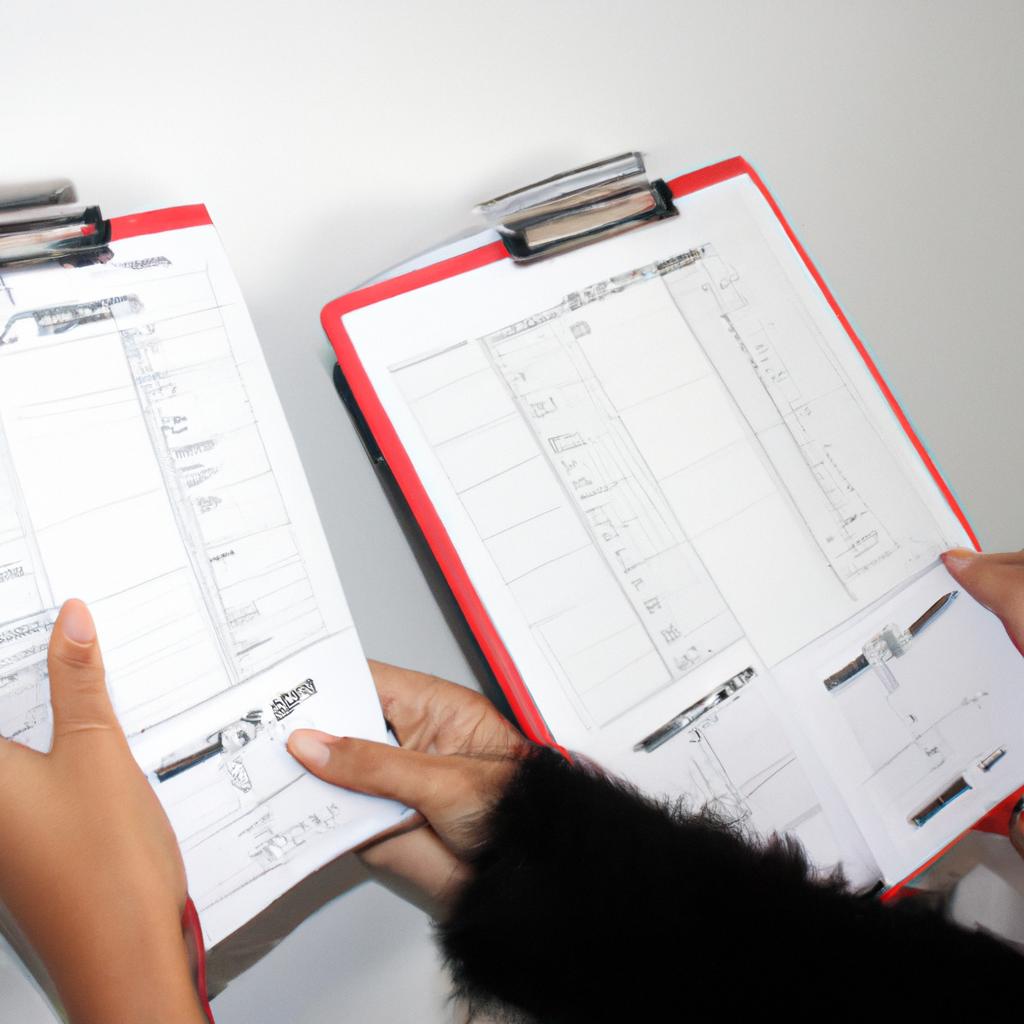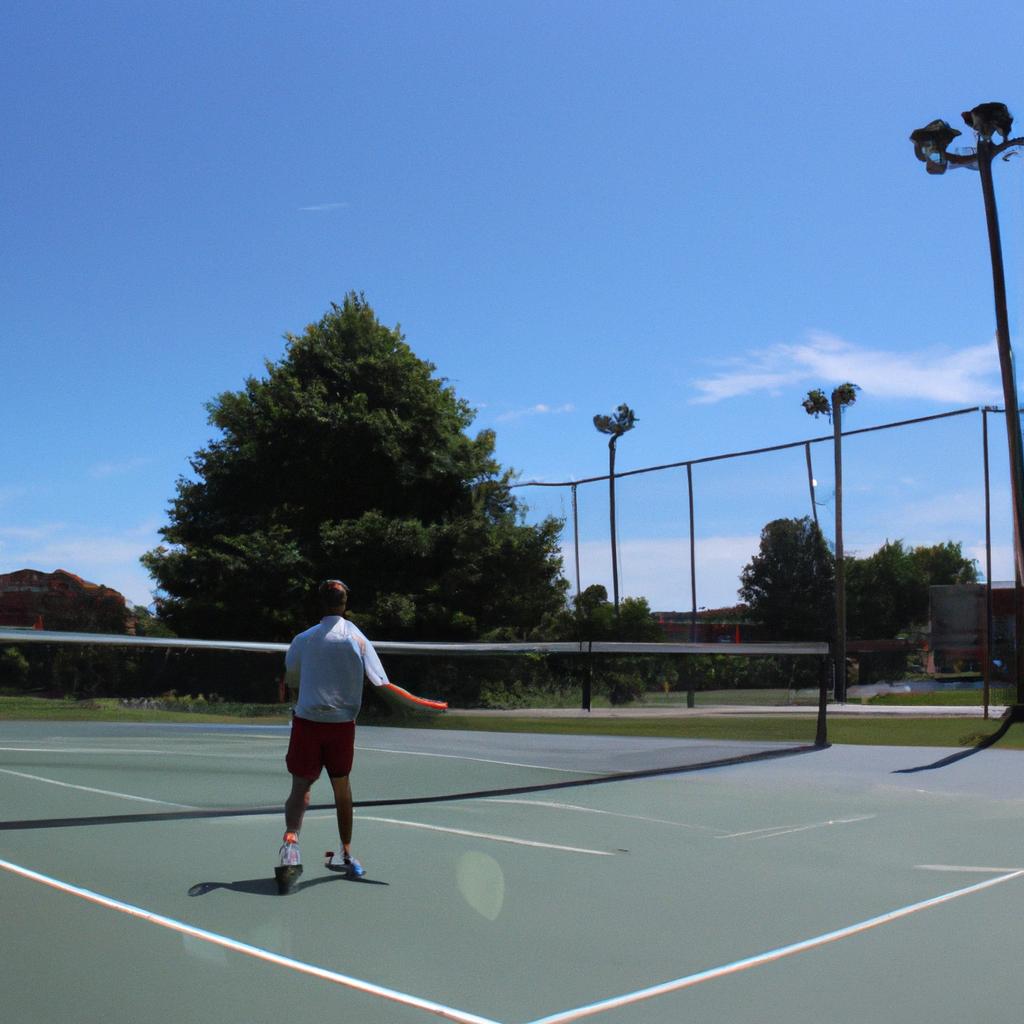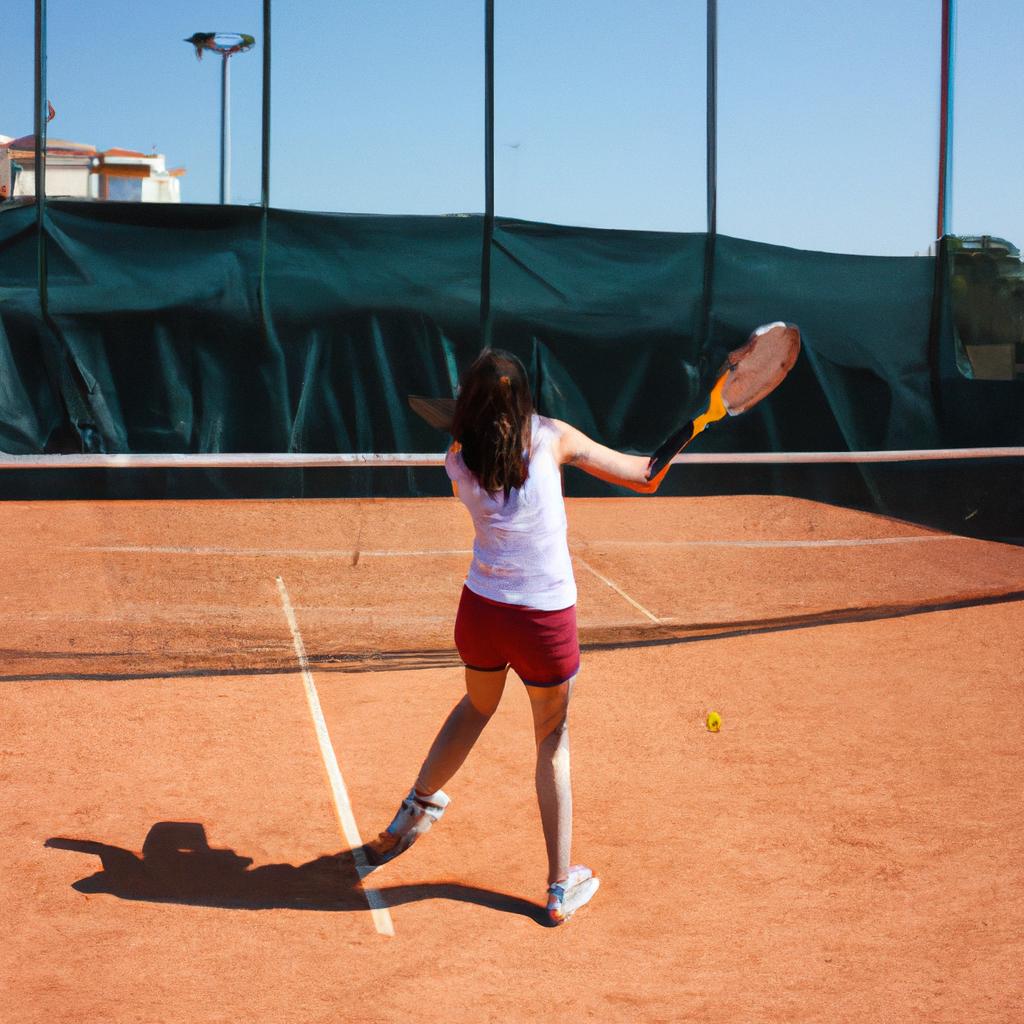Tennis is a sport that demands skill, agility, and strategic thinking. To excel in this game, it is crucial for players to engage in regular practice drills that enhance their abilities. In the bustling city of Baltimore, tennis enthusiasts have access to a variety of lessons and clinics offered by local tennis clubs. These sessions provide an opportunity for players of all levels to refine their techniques and improve their overall performance on the court.
For instance, one popular drill focuses on improving serve accuracy. During this exercise, participants are instructed to aim for specific targets within the service box. By repeatedly hitting these designated areas with precision and consistency, players not only develop better ball control but also gain confidence in their serves. Moreover, another effective drill emphasizes footwork and speed enhancement through ladder exercises. This involves placing a ladder on the ground and instructing players to move quickly between its rungs using precise foot placements. Such drills help athletes improve their agility and coordination while enhancing their ability to cover more ground during rallies.
The availability of lessons and clinics in Baltimore presents aspiring tennis players with a unique opportunity to sharpen their skills under professional guidance. By participating in these training programs, individuals can learn from experienced coaches who employ various innovative practice drills tailored specifically for different aspects of the game.
Warm-up drills
Warm-up Drills
To ensure optimal performance and prevent injuries during a tennis match, warm-up drills are essential. These exercises help players prepare both physically and mentally for the demands of the game. One effective warm-up drill is the dynamic stretching routine. This involves a combination of movements that engage different muscle groups while increasing blood flow throughout the body.
During this warm-up exercise, players can start by performing arm circles to loosen up their shoulder joints and improve flexibility in their upper body. They then progress to leg swings, which target the hamstrings and quadriceps muscles, promoting better range of motion in the lower body. Additionally, high knees and butt kicks can be incorporated to further activate key muscle groups involved in running and jumping.
Engaging in these dynamic stretches not only helps with injury prevention but also enhances overall performance on the court. By incorporating such warm-up drills before practice or matches, tennis players experience improved agility, coordination, and reaction time.
Consider implementing the following bullet point list into your warm-up routine:
- Increased circulation
- Enhanced joint mobility
- Improved muscular flexibility
- Heightened mental focus
Furthermore, utilizing a table format can effectively present various dynamic stretching exercises:
| Exercise | Targeted Muscles | Benefits |
|---|---|---|
| Arm Circles | Shoulders | Enhances upper body mobility |
| Leg Swings | Hamstrings/Quads | Improves lower body flexibility |
| High Knees | Quadriceps | Increases cardiovascular endurance |
| Butt Kicks | Glutes | Activates leg muscles for explosive movements |
By integrating these warm-up drills into training sessions or tennis clinics at our Baltimore club, participants will have an opportunity to optimize their physical preparedness prior to engaging in groundstroke drills.
Groundstroke drills
Transitioning from the warm-up drills, it is important to continue building upon the foundation established during the warm-up phase. Groundstroke drills focus on developing players’ ability to hit powerful and accurate shots from both the forehand and backhand sides of the court. One example that showcases the effectiveness of groundstroke drills involves a hypothetical scenario where a player struggles with consistency in their groundstrokes. By incorporating these specific practice routines, they can enhance their shot-making skills and overall performance.
To further engage participants during groundstroke drills, we have compiled a list of key benefits associated with this training regimen:
- Improved shot control and accuracy
- Enhanced footwork and positioning on the court
- Increased power and depth in groundstrokes
- Heightened ability to anticipate opponent’s shots
In addition to understanding the advantages provided by groundstroke drills, it may be helpful to visualize how such exercises are structured. The following table outlines three popular groundstroke drill variations along with their respective objectives:
| Drill Variation | Objective |
|---|---|
| Cross-Court Rally | Improve accuracy |
| Inside-Out Forehands | Enhance shot placement |
| Baseline Targets | Develop consistent power |
By engaging in these dynamic activities, tennis enthusiasts can experience an emotional connection through improved skill acquisition while also fostering a sense of accomplishment as they witness progress over time.
As we conclude this section on groundstroke drills, let us transition into exploring another crucial aspect of tennis training – serve and volley drills. These exercises focus on honing one’s serving techniques alongside rapid net play strategies, presenting players with opportunities to sharpen both offensive and defensive skills on the court.
Serve and volley drills
Groundstroke drills are excellent for improving players’ consistency, control, and power in their shots. By practicing these drills regularly, tennis club members in Baltimore can enhance their overall game performance. Now let’s shift our focus to another crucial aspect of tennis training: serve and volley drills.
Serve and volley is a classic technique that involves serving the ball aggressively and rushing towards the net to hit a volley before your opponent has time to react. To strengthen this skill set, players can engage in the following practice exercises:
-
Serve Accuracy Drill:
- Aim to serve consistently into specific target areas on the opposite court.
- Start with larger targets and gradually decrease their size as accuracy improves.
- Practice both wide serves (out wide) and body serves (towards the receiver).
-
Approach Shot Drill:
- Begin by serving from one side of the court and then promptly moving forward towards the service line.
- The receiver should aim to return deep balls while you try to execute volleys near the net.
- Alternate sides after each successful rally.
-
Volley Placement Drill:
- Set up several cones or markers on your side of the court at various locations near the net.
- Have a hitting partner feed you balls, aiming for different marker placements.
- Focus on directing your volleys precisely towards each designated target area.
-
Reaction Time Drill:
| Drills | Summary |
|---|---|
| Mirror drill | Mimic your opponent’s movements across the net |
| Quick hands | Practice quick reflexes with rapid volley exchanges |
| Lob challenge | React quickly to lobs by transitioning from baseline to net |
By engaging in these serve and volley drills consistently, tennis players will improve their ability to dominate points through aggressive play at the net. Developing strong serving skills combined with accurate and powerful volleys can give players an edge over their opponents, making it challenging for them to respond effectively.
In the upcoming section about footwork drills, we will explore exercises that focus on improving players’ agility and movement on the tennis court. Developing excellent footwork is crucial for reaching balls quickly and efficiently, allowing players to execute their shots with precision. Let’s dive into these dynamic practice routines next.
Footwork drills
Serve and volley drills are essential for tennis players looking to improve their net game. In this section, we will explore some effective practice drills that can help tennis club members enhance their serve and volley skills.
One example of a serve and volley drill is the “Target Practice” exercise. Players start by serving from the baseline and then quickly move towards the net to hit volleys at designated targets on both sides of the court. This drill not only improves accuracy but also helps in developing quick reflexes needed for successful serve and volley play.
To further strengthen your understanding, here’s a markdown-formatted bullet point list illustrating additional important serve and volley drills:
- Footwork Agility: Incorporate ladder drills to improve foot speed, agility, and coordination.
- Split Step Timing: Practice split stepping just as your opponent hits the ball to be ready for an effective approach shot.
- Shadowing Technique: Perform shadow swings while visualizing yourself hitting perfect serves and volleys.
- Mini-Tennis Games: Engage in small-sided games where you focus solely on utilizing serve-and-volley tactics.
In addition to these drills, it may also be helpful to analyze different scenarios through a table-based case study involving various strategies during a match:
| Scenario | Strategy | Result |
|---|---|---|
| Opponent returns deep | Serve deep, follow with aggressive volley | Point won |
| Opponent lobs over head | Retreat back near baseline, prepare for overhead smash | Point lost |
| Opponent consistently returns low slices | Approach net more cautiously, rely on groundstrokes instead of volleys | Game won |
| Opponent struggles with high balls | Utilize heavy topspin shots followed by strong volleys | Match won |
By incorporating these drills into regular practice sessions and adapting strategies based on specific match situations, tennis club members in Baltimore can significantly enhance their serve and volley skills. The next section will focus on doubles strategy drills, which build upon the foundation of strong net play developed through these exercises.
Doubles strategy drills
Building on the importance of footwork drills, developing effective doubles strategy skills is crucial for tennis players looking to excel in their game. By honing these skills, players can maximize their coordination and decision-making abilities on the court, leading to improved performance. In this section, we will explore some key practice drills that focus specifically on enhancing doubles strategy.
Paragraph 1:
To illustrate the significance of incorporating strategic elements into doubles play, let’s consider a hypothetical scenario where two teams with equal technical ability face off against each other. Team A lacks strong communication and fails to implement proper positioning strategies during rallies. On the other hand, Team B effectively communicates and utilizes smart positioning techniques, allowing them to consistently win points through well-executed shots. This example highlights how mastering doubles strategy can make a significant difference in competitive matches.
Paragraph 2:
In order to develop an understanding of effective doubles strategy, it is essential for players to engage in purposeful practice drills. Here are four key areas to focus on:
- Communication: Effective verbal and non-verbal communication between partners helps establish clear roles and responsibilities during gameplay.
- Court Positioning: Understanding optimal court coverage positions allows players to anticipate shots more efficiently and maintain control over the rally.
- Shot Selection: Making wise shot choices based on factors such as angles, opponent positioning, and playing style contributes significantly towards winning points.
- Net Play: Developing net skills like volleys, overhead smashes, and poaching enables players to take advantage of offensive opportunities when approaching the net.
Bullet Point List (markdown format):
- Increased teamwork
- Enhanced decision-making abilities
- Improved court awareness
- Greater efficiency in executing winning shots
Paragraph 3:
By engaging in these practice drills focused on doubles strategy development, tennis players can experience several benefits both individually and as a team. The enhanced teamwork fosters stronger chemistry among partners while improving overall decision-making abilities. Moreover, by sharpening court awareness and optimizing shot selection, players become more efficient in executing winning shots. These drills not only contribute to individual growth but also create a solid foundation for successful doubles play.
As we have explored the importance of footwork drills and developing effective doubles strategy skills, the next section will delve into conditioning exercises that can further enhance tennis players’ overall performance on the court.
Conditioning exercises
Building on the importance of doubles strategy, we now shift our focus to conditioning exercises. While honing your skills is crucial, maintaining a high level of fitness is equally essential for success on the tennis court. In this section, we will explore three key conditioning exercises that can enhance your performance and endurance during matches.
Paragraph 1:
Imagine a scenario where you find yourself engaged in a long rally with your opponent. As fatigue sets in, your ability to make accurate shots starts to diminish. This situation highlights the significance of incorporating conditioning exercises into your training regimen. By improving your overall physical fitness, you can sustain optimal performance levels throughout extended matches. One effective exercise is interval running, which involves alternating between periods of intense sprinting and moderate jogging or walking. This form of cardiovascular training boosts stamina and replicates the start-stop nature of tennis gameplay.
- Increased agility
- Enhanced speed and reaction time
- Improved muscular strength
- Enhanced mental resilience
Paragraph 2 (with table):
To further illustrate the benefits of these conditioning exercises, let us examine how they contribute to various aspects of tennis performance:
| Aspect | Conditioning Exercise |
|---|---|
| Cardiovascular | Interval running |
| Agility | Ladder drills |
| Muscular Endurance | Circuit training |
| Mental Resilience | High-intensity interval training |
By incorporating these exercises into your routine consistently, you can expect notable improvements across several vital areas required for successful play.
Paragraph 3:
In summary, while focusing on developing strategic prowess is essential for doubles play, it is equally important to prioritize your physical well-being through targeted conditioning exercises. Incorporating interval running as part of your cardio routine alongside ladder drills, circuit training, and high-intensity interval training can yield significant benefits. By embracing these exercises, you will enhance your agility, speed, reaction time, muscular strength, and mental resilience—all crucial components for excelling in the game of tennis.
(Note: The markdown format for bullet points and tables may not be displayed correctly here as it depends on the platform or text editor being used.)




